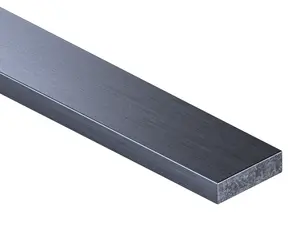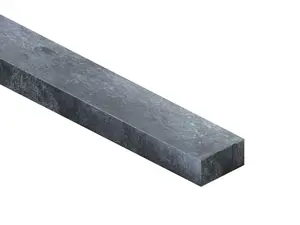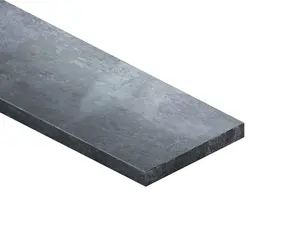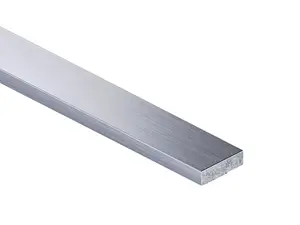Hot rolled flat bars (<= 150 mm)
734 variantsHot rolled wide flat bars
158 variantsStainless flat bar hot rolled
58 variantsFlat bars are a versatile component that is used in many fields - from steel construction to furniture making to precision mechanics. Thanks to its simple form, steel flat bar provides reliability and durability, which makes it indispensable in many projects.
Our offer includes various types of flat bars, so as to meet the expectations of even the most demanding customers.
Characteristics of flat bars
A steel flat bar is a type of long product, the cross section of which is rectangular. These products are relatively simple to manufacture and have great versatility in many industrial sectors, especially in steel structures. Depending on the production technology, we distinguish different types of flat bars.
Drawn flat bars are products produced by the drawing process, in which steel is drawn through a die to obtain the desired dimensions and properties. This process ensures high dimensional accuracy of steel flat bars and uniformity of structure. The surface of drawn flat bars is smooth and free of any defects such as cracks or scratches.
Hot-rolled flat bars with a width of 150 mmor less are produced by the hot-rolling process. In this technology, the steel flat bar is heated to the austenitic transformation temperature and rolled between the rollers of a rolling mill. This results in products with consistent, controlled steel flat bar dimensions and excellent mechanical properties.
Hot-rolled wide flat bars, on the other hand, are produced in a similar way, but have larger dimensions in terms of width. These are products that can have significantly larger dimensions than standard hot-rolled flat bars. The production of these flat bars requires specialized rolling mills capable of processing such wide strands of steel.
Features and advantages of flat bars
Features of flat bars:
Drawn flat bars:
- Precise dimensions of steel flat bars due to the drawing process.
- Smooth and uniform surface. o Uniform crystal structure of steel.
- No internal stresses.
Hot-rolled flat bars <= 150 mm:
- Fixed and controlled dimensions of steel flat bars.
- Natural matte surface. o Strength and mechanical properties corresponding to standards for hot-rolled flat bar.
- High ductility at elevated temperature.
Hot-rolled wide flat bars:
- Wide width in the size range of steel flat bars. o High strength and uniformity.
- Ability to produce flat bars with non-standard width.
- Mechanical properties typical of hot-rolled steel products.
Advantages of flat bars:
Drawn flat bars:
- High dimensional accuracy ideal for precision applications.
- Optimal surface quality for direct machining or painting.
- No need for additional heat treatment due to homogeneous structure.
Hot-rolled flats <= 150 mm:
- Excellent strength while maintaining ductility. o Wide availability on the market due to standard steel flat bar dimensions.
- Easy to weld and machine.
Hot-rolled wide flat bars:
- Customizable to meet specific customer needs due to wide dimensions.
- High uniformity and strength for critical structural applications.
- Optimal mechanical properties for large structures.
Steel grades
We offer square flat bars in C45 (1.0503), C45+C (1.0503), C45E (1.1191), C45E+C (1.1191) and S235J2 (1.0117) steels.
C45 (1.0503)
Features:
- Carbon steel with medium carbon content. Can be hardened. Provides good hardness after quenching and adequate mechanical strength.
Advantages:
- Good machinability, can achieve high hardness, high tensile and bending strength. Ideal for parts that require some hardness while maintaining some ductility.
Disadvantages:
- May require additional heat treatment for optimal properties. Not corrosion resistant.
C45+C (1.0503)
Features:
- This is a variation of C45 steel that has undergone an additional quality improvement process.
Advantages:
- It has all the advantages of C45, but with additional improvements in microstructure and better uniformity and continuity.
Disadvantages:
- Higher cost compared to C45 due to additional processing.
C45E (1.1191)
Features:
- Medium carbon steel with the addition of dopant elements such as manganese, silicon, etc.
Advantages:
- High mechanical strength
- Better weldability compared to C45.
- Good hardness and wear resistance.
Disadvantages:
- Requires careful heat treatment for optimum properties.
- Lacks corrosion resistance.
C45E+C (1.1191)
Features:
- A variation of C45E that has undergone additional processing to improve quality.
Advantages:
- Higher homogeneity and continuity of structure compared to C45E.
- Better weldability.
- Higher resistance to fracture.
Disadvantages:
- Higher cost compared to C45E due to additional processing.
S235J2 (1.0117)
Features:
- Low carbon structural steel with dopant elements.
Advantages:
- Good weldability, ductility and toughness.
- Suitable for structures that require good bending and tensile strength at lower cost.
Disadvantages:
- Lower hardness and strength compared to the aforementioned steels.
- Not corrosion resistant without proper surface treatment.
Applications of flat bars
Steel flat bar is an extremely versatile material that is used in many industrial sectors. It is mainly used as a structural element in the construction, engineering and transportation sectors. Due to their simplicity and versatility, flat bars are a basic component of many structures.
Drawn flat bars are used where dimensional precision and a smooth surface are required. Thanks to their excellent mechanical and aesthetic properties, they are often used in the precision industry, in the manufacture of tools, machinery and in other constructions where high accuracy is required.
Hot-rolled flat bars <= 150 mm are widely used in construction and medium-sized steel structures. Thanks to their optimal mechanical properties and flexibility, they are ideal for structures that must withstand significant loads, such as machine frames, bridge structures and building supports.
Hot-rolled wide flats, due to their larger dimensions, are often used in large engineering and construction structures, such as large steel structures, foundations or bridge elements.
Tips for investors
- Exact specifications - make sure you know the exact dimensions of steel flat bars and other parameters that are necessary for your project. This will make it easier to choose the right product.
- Choose the type of steel - not all grades of steel have the same properties. Make sure you choose the right steel for your application, especially when it comes to drawn flat bars.
- Check the quality - for drawn flat bars, surface quality is crucial. Pay attention to uniformity, absence of defects and flaws.
- Verify the supplier - make sure the supplier has the proper certifications for the flat bars it sells.
- Adapt to the structure - if your structure requires large, heavy-duty components, hot-rolled wide flat bars may be the best solution.
- Supply planning - plan your purchases well in advance, especially if non-standard steel flat bar dimensions or specific mechanical properties are required.
Storage of flat bars
- Horizontal ground - make sure flat bars are stored on a horizontal ground to ensure stability and avoid bending.
- Protection from moisture - store flat bars in a dry place, away from sources of moisture, to prevent corrosion. For outdoor storage, use appropriate protection.
- Protection from damage - avoid impacts or scratches when handling and storing flat bars. Use appropriate lifting equipment.
- Regular inspections - regularly check the condition of flat bars in storage to quickly detect any signs of corrosion or other damage.
- Accessibility - make sure access to each flat bar is easy to avoid unnecessary movement and potential damage to other units.
Did you know
- Flat bars are one of the most versatile steel products, used in both precision engineering projects and general building structures.
- Although flat bar manufacturing technologies have evolved over the years, the basic methods of rolling steel into flat bars have been known for centuries, attesting to their indispensable role in construction and engineering.
- Thanks to modern production techniques, the dimensions of steel flat bars can be maintained to the nearest hundredth of a millimeter, which makes it possible to use them in specialized constructions where high precision is required.
- Despite their simple shape, flat bars have significant load-bearing capacity, due to their geometric characteristics and the material properties of the steel.
- Steel flat bars can be subjected to various machining processes, such as cutting, bending, welding and turning, making them an extremely versatile material for engineers and designers.
Flat bars - why with us?
At Moris steel wholesaler you will find a wide range of flat bars tailored to the most specific requirements. Our team of specialists guarantees professional service, technical advice and support at every stage of cooperation. With a variety of delivery methods, we provide fast and flexible order fulfillment, tailored to the individual needs of our customers.
We cordially invite you to make a purchase!
FAQ
How much does a meter of flat bar weigh?
The weight of a meter of flat bar depends on its dimensions, more specifically on its thickness and width. To calculate the weight of a flat bar having a meter in length, the following formula is used:
weight = width [mm] x thickness [mm] x 0.00785 [kg]
For example, a 20 mm x 5 mm steel flat bar weighs about 0.785 kg per meter (20 x 5 x 0.00785).
Remember, however, that the above formula calculates the weight for steel flat bars. For other materials, such as aluminum or copper, the factor of 0.00785 will be different as it relates to the density of steel.




